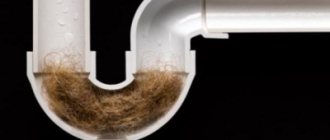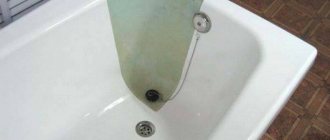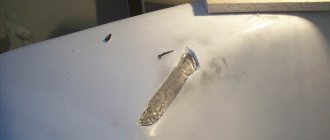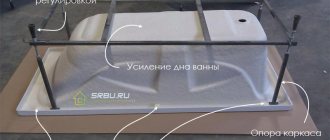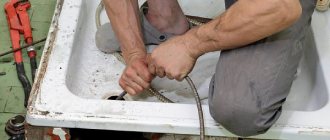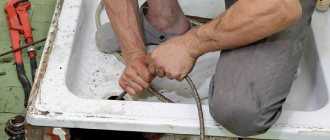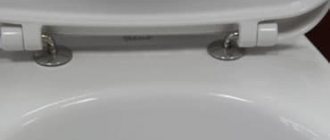Acrylic bathtubs are increasingly being chosen by consumers to replace steel and heavy cast iron ones that have become unusable. Indeed, such plumbing fixtures are characterized by a very attractive, neat appearance; they are distinguished by their light weight and exceptional whiteness. In addition, they are available in a very wide variety of shapes and sizes.
Caring for an acrylic bathtub at home
In addition, acrylic products have a number of other advantages, one of which is complete inertness to corrosion. However, this does not relieve the owners of the responsibility to regularly clean surfaces. And in general, caring for an acrylic bathtub at home should be systematic - only in this case will it retain its original newness for many years. By the way, similar rules should be followed by those homeowners who have updated old steel or cast iron bathtubs with acrylic inserts.
Everything from A to Z about the properties of an acrylic bathtub surface
Acrylic is a multicomponent polymer material obtained as a result of the synthesis of acrylic, methacrylic acids and fillers, soluble in water. To harden the acrylic, a hardener is added. After drying, acrylic is guaranteed to acquire a stable color and a reliable, durable coating for many years, which requires systematic and proper care. An acrylic bathtub is a plastic bathtub with a layer of acrylic applied to the inner surface. There are acrylic bathtubs with and without a reinforced layer, but the care for all types of acrylic bathtubs is the same.
How to care for an acrylic bathtub at home and what to clean it with? To answer this question, let's first get acquainted with the properties of acrylic bathtub coating, since these pros and cons directly affect recommendations for the proper use and care of such bathtubs.
Properties of acrylic bathtub surface
First, let's consider all the advantages and advantages of acrylic bathtubs: • a snow-white glossy acrylic surface, which has a very neat, aesthetic and attractive appearance, leaves no one indifferent, as they say - pleasing to the eye; • low thermal conductivity coefficient allows you to maintain the temperature of the collected hot water for a long time. In such bathtubs, the water remains warm much longer than in cast iron and steel bathtubs; • increased antibacterial properties of the acrylic coating due to the absence of micropores in the surface, which prevents various bacteria and microorganisms from collecting on the surface of the bathtub. Moreover, this is important at constant high humidity and temperature in bathrooms, where the most favorable conditions usually exist for the emergence and spread of various kinds of bacteria and microorganisms; • during the operation of the bathtub, chips often appear on its surface from impacts of various heavy objects. If the impact damages the enamel that covers steel and cast iron bathtubs, then a source of corrosion will inevitably subsequently arise in this place. This does not affect the surface of acrylic bathtubs, which is also one of the advantages of acrylic bathtubs. Plastic baths never corrode; • plastic bathtubs, on which a layer of acrylic is applied, are lightweight. This is a big advantage during transportation, lifting and installation compared to cast iron bathtubs; • acrylic bathtubs come in a variety of shapes, designs and sizes. A large selection of models of such plumbing products is also one of the advantages when a buyer chooses between an acrylic and a cast iron or steel bathtub; • the acrylic surface of the bathtub is very easy to clean from dirt at home. Cleaning products are produced by many manufacturers and are very affordable for almost any consumer. Along with so many advantages of acrylic bathtubs, there are also disadvantages of acrylic surfaces. All the disadvantages and disadvantages of acrylic bathtubs: • low resistance to high temperatures. Acrylic cannot withstand and begins to melt at temperatures of 100 degrees Celsius and above. Naturally, almost no one allows water with a temperature close to 100 degrees Celsius to enter the bathtub, but very hot water, combined with great mechanical stress from the large weight of the collected water, sometimes leads to deformation of the surface. This primarily applies to inexpensive bathtub models that are made from cheap and thin plastic; • although acrylic bathtubs have a certain hardness and strength, do not forget that they are still plastic. The highest quality and most expensive plastic will serve you for a maximum of 10 years, after which it begins to lose its properties. In addition, it should be noted that cheap samples of acrylic bathtubs are made of thin plastic, the strength of which is far from that of their expensive counterparts. Sometimes this leads to the fact that the weak plastic bottom simply cannot withstand the loads of the accumulated water and the weight of the human body. As a result, the acrylic bathtub cracks, and in most cases cracks through, which can lead to flooding of the neighbors on the floor below; • at the same time, the surface of an acrylic bathtub is easy to scratch, and with a strong impact, it can be pierced through; • possible yellowing of the acrylic surface of the bathtub after a certain period of time. Yellowness does not always occur. If low-quality materials were used in the production of an acrylic bathtub, in particular a hardener, then the appearance of yellowness after a certain period of time is inevitable. Yellowness also appears due to exposure to chlorine, which is present in certain quantities in tap water; • low resistance of acrylic coating to household chemicals. When caring for an acrylic bathtub at home, you should not use any detergents or cleaning products. In simple words, acrylic bathtubs cannot be washed with anything. Acrylic is afraid of household chemicals containing: • chlorine and all its varieties - the surface under the influence of chlorine loses its shine, turns yellow and slowly deteriorates due to the formation of pores, which reduce the life of the product; • acetone and other solvents corrode plastic, resulting in cloudiness and dents; • ammonia, as well as most bleaches that contain it, destroys the molecular structure of acrylic; • all formaldehydes are incompatible with all types of acrylates in their composition; • under the influence of alcohols, alkalis and acids, acrylic melts. In order for your new shiny acrylic bathtub to serve for a long time and delight the eye with its radiant appearance, it is necessary to take into account all the above features of the properties of acrylic bathtub surfaces.
What is acrylic
Victory over the enemy is achieved not only by fortitude, but also by knowledge of his strengths and weaknesses. This expression fully applies to the care of acrylic bathtubs. Without knowing the characteristics of the material and its weaknesses, it is impossible to understand what means can and should be used to clean a bathtub made of such an unusual material as acrylic. The term “acrylic” hides a range of completely different polymer materials made from methacrylic and acrylic acid: fabrics, glass, plastic.
Bathtubs are made from plastic. Acrylic bathtub has a smooth, shiny surface that is pleasant to contact. The material retains heat perfectly, is technologically advanced (you can get the shape of a bowl of the most bizarre shape), and durable.
At the same time, strength is not synonymous with the word hardness - the surface of the bathtub can be easily scratched, and with a concentrated impact it can be pierced through (a glass perfume bottle falling from a shelf is enough).
The material is afraid of hot water (above 85oC the plastic softens, deforming the walls of the bowl) and household chemicals containing:
- all types of chlorine - the surface, firstly, loses its shine and turns yellow, and secondly, it slowly deteriorates (pores are formed, shortening its service life);
- acetone - corrodes plastic, the first sign of which is its cloudiness. 10 ml of acetone is enough to make a dent;
- ammonia (almost all types of bleaches) - destroys the molecular structure of the material;
- formaldehyde in its composition is incompatible with all types of acrylates;
- alcohols, alkalis, acids melt acrylates.
Therefore, it is important to take into account all the above nuances of caring for an acrylic bathtub so that it serves for a long time, delighting its owners. Let's talk about the features of care in detail.
Proven equipment for caring for an acrylic bathtub
To clean the surface of the bathtub, use soft ordinary sponges, soft rags with lint, such as flannel and microfiber, and fabric napkins. It is strictly forbidden to use any sponges that have an abrasive coating, which can scratch the acrylic coating. Do not use hard brushes, scrapers, sponges or scourers.
The acrylic coating scratches easily. We do not recommend storing metal or sharp objects on the shelves above the bathtub. If such objects are accidentally dropped, chips and scratches may occur.
What can't be used?
One drawback of this item is the unreliable coating; one might say there is practically no protection. This is why acrylic surfaces are easily scratched and damaged by detergents. The acrylic surface quickly becomes dull and changes color when using the “wrong” detergents.
What products should not be used for care:
Secrets of experiments: folk remedies - benefit or harm?
Here we provide a list of folk remedies that can be used correctly to wash away certain types of stains. However, we do not recommend their constant use for cleaning acrylic bathtubs at home, if only because none of them restores the acrylic shine of the bathtub coating.
Baby soap
We do not recommend constantly using baby soap, although it is made from ingredients that are safe for the health of the child.
Using baby soap, you can wash fresh, small stains just once, but not all of them. Therefore, baby soap is unsuitable for the permanent care of acrylic bathtubs.
Laundry soap
During the collapse of the former USSR at the end of the last century and the total shortage, laundry soap as a means for cleaning bathtubs became very widespread.
Firstly, laundry soap, due to its low cost, was widely available. Secondly, laundry soap was always produced in sufficient quantities and was never a scarce product. Thirdly, laundry soap was absolutely safe in its chemical composition.
If anyone remembers, in those days infants were bathed with laundry soap. In those days, the use of laundry soap was entirely justified. But times change, and laundry soap is no exception. GOST standards have been changed several times over the course of several decades. Accordingly, the chemical composition of laundry soap has changed a lot, and not for the better.
As they say, now “the entire periodic table” is in laundry soap. Therefore, now it should not be used as a detergent for cleaning acrylic bathtubs, and at maximum, you can simply damage the acrylic coating with the aggressive components included in its composition.
This is not only a theory, there are also not isolated cases in practice when a new acrylic bathtub was constantly washed with laundry soap. The result is that after 6 months the bathtub lost its appearance and turned yellow. Many websites advise using laundry soap at home.
Should I use it or not? It's up to you to decide, but we strongly recommend not to do this. If “finances generally sing romances,” it’s better to buy an inexpensive “Cinderella” cream for acrylic baths. When cleaned with Cinderella, the surface of the bathtub is guaranteed not to be damaged.
Liquid soap
On many sites you can also find advice on using liquid soap, various gels, and so on. It's up to you to decide whether to use them or not. We definitely do not recommend doing this. Moreover, all these funds do not fall on you from heaven, and also have their own price, in any case no less than the cost of “Cinderella”.
Table vinegar
Vinegar is very good at removing limescale, but, on the other hand, it can also damage the surface of your bathtub. Therefore, we also do not recommend its use.
Hydrogen peroxide
To enhance the cleaning effect, some experts recommend using table vinegar and adding hydrogen peroxide to it. Proportion: 3 parts table vinegar and 1 part hydrogen peroxide. We do not recommend doing this.
Citric acid solution
With the help of citric acid, you can cope with surface contamination of bathtubs such as rust and limescale. A solution of lemon juice is good at corroding fat deposits. This remedy is perhaps the only folk remedy that can be safely recommended for use.
Cleaning with citric acid does not take up your time. The recipe is very simple: • fill the bath with warm water; • dissolve citric acid (50 g) in a small amount of warm water; • pour the prepared solution into the bath; • mix the water well and leave to brew for 10-12 hours; • drain the water, wash the bathtub with warm water and wipe with a dry cloth.
Baking soda or Pemolux
Grandma's proven cleaning product. Sodium is able to perfectly break down fats and other organic compounds. However, there is a high chance that some sodium crystals may not dissolve in the prepared mixture and you will simply scratch your acrylic bathtub. This is at a minimum, at a maximum - soda will eat up all the gloss and the surface of your bathtub will remain matte forever.
Some people advise diluting baking soda with plenty of water. But the effect of such dilution, you will agree, will be appropriate. Therefore, we do not recommend using baking soda as a cleaner for acrylic bathtubs.
Toothpaste
Toothpaste is the best solution for cleaning acrylic bathtubs. Although this remedy is more related to household chemicals, and not to folk remedies. In any case, the effectiveness of a given cleaning product comes up against the cost of care. Therefore, using toothpaste to clean the entire surface of an acrylic bathtub is very expensive and impractical.
But in some cases, toothpaste is still used to clean a certain area of the bathtub surface that has, for example, gotten hair dye or other dyes. Rub toothpaste onto the damaged area using a rag or sponge. Wait a few minutes. Rinse off the toothpaste with warm water and wipe the area with a dry cloth.
However, there are toothpastes that contain abrasive inclusions. The hard particles of such pastes can scratch the surface of your bathtub. Therefore, check toothpastes for abrasive particles before use.
How to properly care
To clean the bathtub, use a soft cloth with liquid soap. Before cleaning, you need to wipe the surface with a dry cloth to prevent the settling of plaque, which may be contained in water with increased hardness. Use special wet wipes for bathrooms.
Use specialized gels for acrylic. As a rule, they are applied to the surface and washed off after a few minutes. In addition, you can treat the bath using a mixture of water, vinegar and lemon juice.
General cleaning
To combat severe stains, use a vinegar solution. Pour hot water with vinegar and leave to stand until morning. Rinse off in the morning. Then rinse and dry the container. The second method is to fill a container with warm water with a disinfectant dissolved in it.
Leave the bath with the solution for about half an hour, then drain the water and dry.
How to clean rust, plaque and stains
Limescale deposits can be removed by using lemon juice. Treating with soda mixed in water will help prevent rust. Rust stains can be treated quickly and effectively by covering them with ammonia or hydrogen peroxide.
What to do with scratches
Special kits, which are usually supplied with the bathtub and are also sold in plumbing stores, will help you deal with scratches on the surface. The kit includes liquid acrylic or epoxy putty and a spatula. Using this kit, you can easily and quickly treat any damage, even deep ones.
Review of folk remedies
In addition to specialized products for cleaning acrylic, folk remedies such as citric acid, soda and toilet soap demonstrate effectiveness.
Lemon acid
Using citric acid, you can effectively treat dirt and rust stains on the surface of the bathtub. This substance is safe for the material and does not damage the bath.
Baking soda
A baking soda solution is also suitable for regular bath cleaning. You can use a mixture of baking soda and soda ash in equal proportions, carefully applying it to a damp surface.
Toilet or baby soap
To maintain cleanliness, regular cleaning with a soft brush and regular toilet soap is usually sufficient. However, this method will not get rid of rust stains and limescale.
You need to know what not to do when caring for an acrylic bathtub?
To ensure that the surface of your acrylic bathtub always remains shining and shiny, we strictly prohibit doing the following:
• soak laundry. With prolonged exposure of the acrylic coating to an aqueous solution of washing powder, the surface of the bathtub will quickly lose its snow-white and glossy appearance; • dye your hair, dye pigments may be absorbed into the surface of the bath; • use products containing in their chemical composition alcohol-containing solvents, bleach, chlorine, acetone, oxalic acid, such cleaning products as “Comet”, “Biolan”, “Sanox”, “Domestos”, “Pemolux” and others. These products are intended for the care of ordinary baths. They can not only make the glossy surface matte, but also deform the acrylic coating itself; • for cleaning, you cannot use all types of hard brushes, sponges and scrapers with abrasive applied; • if you have pets bathing in an acrylic bathtub, place rubber mats on the bottom, otherwise pets with their claws can cause scratches of varying depths on the surface of the bathtub; • we do not recommend washing dishes in an acrylic bathtub; • it is unacceptable to wash bicycles and various spare parts in an acrylic bath; • since acrylic begins to melt at a temperature of 100 degrees Celsius and above, therefore, boiling water from a kettle cannot be poured onto the surface of an acrylic bathtub. Usually in the summer the hot water supply is turned off for 2 weeks. The bath becomes icy, and it is unpleasant to take water procedures in it. Some people pour boiling water over the surface of the bath, some heat it with hair dryers. Sometimes ice is thrown into the bathtub from the freezer compartment of the refrigerator and a kettle of boiling water is poured on top so that the ice quickly melts. Doing this can damage the surface of your acrylic bathtub.
How to disinfect
Disinfection is carried out in order to clean plumbing fixtures from various microorganisms that have a detrimental effect on humans. Fungi and fungus love moisture, and it is an ideal breeding ground for them, so appropriate measures need to be taken.
You can disinfect with a weak solution of “Whiteness”, soda (just do not rub), lemon juice, vinegar or laundry soap. To do this, the product is applied to the surface of the bath and left for 15 to 45 minutes. Then you need to rinse with water and wipe the bath with a clean soft cloth, which will add additional shine.
Is it still necessary to disinfect the bathtub and how?
Daily care of an acrylic bathtub - rinse with warm water and wipe dry with a clean cloth. Clean with detergent once a week. At the same time, a fatty coating forms on the walls of the bathtub within a week, which is an excellent breeding ground for fungus and other harmful bacteria.
The fungus reproduces well on silicone sealant, which is used to seal the joints of the walls of the bathroom and bathtub. If you regularly wash your bathtub every week with cleaning products, then there is no additional need to disinfect your acrylic bathtub.
But if you forget or you don’t have time to clean the bathtub once a week with detergents, then it is advisable that you do a complete disinfection of the acrylic bathtub.
If you bathe a small child under 1 year of age in the bathtub, disinfect the bathtub at least once a week. After completing disinfection, wash the bathtub walls with baby soap.
There are several ways in which you can completely disinfect an acrylic bathtub:
• 1st method: treatment with special disinfectants Acrilan, Acrilight, or Santekh. When purchasing, pay attention - the packaging must contain a warning about the absence of chlorine. If there is no such inscription and it is not known whether the product is suitable, then conduct a small experiment - apply a small amount of disinfectant to a small area of the bath and wait 10-15 minutes. If no changes occur in the treated area, then you can treat the entire surface: • first rinse the bathtub with warm water, • then apply a disinfectant to a soft sponge and wipe the entire surface with it, • wait 1-2 minutes and rinse off the applied product with hot water, • Wipe the entire surface of the bathtub dry with a clean cloth.
• 2nd method: treatment with “Belizna”: • fill the entire bath bowl with warm water, • pour two 1 liter bottles of 7% “Belizna” into the bath, • wait 10-15 minutes and pour the solution into the drain hole, • Fill the entire bathtub bowl again with warm water, • wipe the entire bathtub with a sponge, • pour the water into the drain hole, • rinse the bathtub with warm water, • wipe the entire surface of the bathtub dry with a clean cloth.
• 3rd method: treatment with a steam cleaner or steam generator. Hot steam perfectly kills any germs and bacteria, and also removes contaminants. Acrylic melts at temperatures of 100 degrees Celsius and above. Therefore, in order not to melt the acrylic coating of the bathtub, treat with a steam generator with great care, without holding the steam stream in one place.
How to make your own bath cream?
Folk remedies made from improvised ingredients can completely replace professional products for cleaning acrylic bathtubs. In one of the simplest recipes. You need to prepare half a liter of hot water, 15-20 g of baby soap, 100 g of soda, aromatic oils for scent.
Rub the soap on a fine grater, add water and leave. After a few hours, mix the thick soap solution with soda. For aroma, add a few drops of tea tree oil, bergamot, orange or lemon.
Soak a soft cloth or sponge with the resulting mixture and thoroughly wipe the surface of the bathtub. Leave for half an hour, then wash off - cleanliness and a pleasant smell are guaranteed. The home remedy does not harm acrylic and is absolutely safe for the skin of your hands.
TOP 10 best ways to eliminate pollution
If, nevertheless, dirt has formed on your bathtub that is not washed off with the usual care procedure, then read our tips for cleaning the bathtub from various contaminants.
Each type of pollution has its own methods of eliminating pollution. Next, we will analyze in detail all types of contamination, and you will know how to clean an acrylic bathtub in each specific case:
Yellowness
Acrylic bathtubs turn yellow depending on various reasons. More details about yellowness are described on our website in the article “Why does an acrylic bathtub turn yellow.” In each case, you first need to understand the reason for the yellowness of the acrylic bathtub in order to know what detergent to use. If you cannot determine the reasons for the appearance of yellowness, then you need to follow the following methods for eliminating yellowness in the same sequence:
• 1st method: take 3 parts of 9% table vinegar and 1 part of hydrogen peroxide. Mix them and pour the prepared solution into a spray bottle. Spray the yellowed stain and wait 15 minutes. If you don’t have a sprayer, apply the prepared solution to the yellow spots with a sponge or cloth. Wait 15 minutes, then thoroughly wash the stain with warm water and wipe it dry.
• Method 2: Mix 1 part mustard powder with 1 part baking soda and dilute the mixed mixture in warm water to a paste consistency. Apply the mixture to the yellow stain. Wait 30 minutes, then thoroughly wash the stain with warm water and wipe it dry.
• The 3rd method of eliminating yellowness on the surface of a bathtub is the best, but at the same time very expensive: apply toothpaste to the yellow spot. Wait 5-10 minutes, then thoroughly wash the stain with warm water and wipe it dry. If the entire surface of the bathtub has turned yellow, to treat the surface, apply toothpaste to a sponge and treat part of the surface. After this, repeat applying the paste to new areas. After treating the entire bathtub, thoroughly wash the bathtub with warm water and wipe it dry with a dry cloth.
Limescale
• 1st method: 9% table vinegar is used to remove limescale. Pour no more than 1 liter of vinegar into a bathtub filled with warm water and stir it very well in the water. Leave the bath for 10 hours, no more. Then drain the water and wash the bath thoroughly, first with warm water, then with cold water. Then wipe the bathtub dry with a dry cloth.
• 2nd method: baking soda can also be used to remove limescale. But baking soda is a very good abrasive. Therefore, it must be handled with extreme caution, otherwise at least scratches cannot be avoided. It is best to use soda in the form of a paste: dilute baking soda in water until it has the consistency of sour cream. Apply the resulting mixture to damaged areas. Wait for 20-25 minutes, then wash the area with warm water and wipe it dry.
• 3rd method: citric acid is used to remove limescale. Pour 200 g of citric acid into a bathtub filled with warm water and mix very well. Leave the bath for 8-10 hours. Then drain the water and wash the bath thoroughly, first with warm water, then with cold water. Then wipe the bathtub dry with a dry cloth.
Rust
• Method 1: Apply freshly squeezed lemon juice to the rusty damaged area. Wait 1 hour, then thoroughly wash the stain with warm water and wipe it dry. To enhance the effect, you can also use table salt. Stir the salt until it becomes powdery and mix with lemon juice. Apply the resulting slurry to the rust-damaged areas of the bathtub. Wait 1 hour, then thoroughly wash the areas of the bathtub with warm water and wipe dry with a dry cloth. But do not rub under any circumstances, otherwise the acrylic shine will disappear. If necessary, repeat the procedure.
• 2nd method: to remove fresh rust, use a solution of hydrogen peroxide and ammonia in a 1:1 ratio, add a little warm water to it. Apply the resulting solution using a sponge or swab to the darkened areas. Wait 5-7 minutes, no more. After this, thoroughly wash the treated areas of the bath with warm water and wipe dry with a dry cloth.
Glue
You can remove any remaining glue with a cloth soaked in citric acid dissolved in water.
Silicone sealant
Silicone sealant is the most problematic because it adheres very tightly to the acrylic surface and it is almost impossible to replace it without damaging the acrylic coating. Silicone sealant constantly attracts moisture and over time it turns black and becomes covered with mold.
The sealant can only be washed with a cloth soaked in one of the substances: citric acid dissolved in water, white spirit or vinegar essence. Apply the sealant, wait 7-10 minutes and be sure to rinse the treated areas with warm water. If the first time it was not possible to completely wash off the blackness, repeat the procedure again.
Please note that the above methods are only recommended for cleaning old stained areas. For regular maintenance, use the methods and products indicated in the section “How to wash an acrylic bathtub.”
What compositions can be used for acrylic plumbing?
You should tell us in more detail about ready-made detergents suitable for cleaning polymer baths - what you need to pay attention to when choosing them.
- The packaging of specialized compounds should indicate that they are safe for plumbing accessories made from acrylic.
- In addition to specially designed compositions for cleaning acrylic surfaces, some universal solutions are also suitable, but they should not contain aggressive ingredients, such as certain types of acids, acetone, alcohol and ammonia.
The disadvantage of ready-made detergents for acrylic products is their high price, and also the fact that their use must be strictly dosed. It should be noted that domestic cleaning solutions have a more affordable price, although they often have a completely similar effect to imported compounds.
Ready-made patented acrylic care products
The advantage of ready-made chemical-based cleaning products is that they not only remove dirt, limescale, rust and yellowness from acrylic, but also create a protective, visually invisible film on its surface.
So, among all the existing compositions for cleaning acrylic, we can highlight the following compositions that have earned positive feedback from users:
| Illustration | Name and brief characteristics of the detergent |
| “Akrilan” - this composition is a cleaning foam designed to eliminate contaminants such as limescale, soap stains and rust. The product easily copes with different types of stains. After washing off the foam, a protective film remains on the surface of the acrylic, which prevents the accumulation of dirt in the pores of the material. For the composition to be effective, it should be used in accordance with the instructions provided by the manufacturer. It is very important not to leave the foam applied on the surface until completely dry. In addition, it is unacceptable to mix Acrilan with other detergents. | |
| “DEC” - this product is produced in the form of a cream and is intended for cleaning not only acrylic sanitary ware, but also tiles, chrome and other surfaces. The composition includes antiseptic additives that prevent the proliferation of harmful bacteria and fungal formations in hard-to-reach places of plumbing accessories. At the same time, when rinsed off, the product perfectly cleans the sewer system. Has a beneficial effect on metal parts of hydromassage bathtub models. | |
| “Triton” is a fairly popular product for cleaning acrylic bathtubs, which can be sold as a concentrate or a ready-to-use solution. The concentrate is sold in large containers and is intended for the active fight against serious pollution and for large-scale sanitary treatments to prevent the spread of bacteria. The solution is usually packaged in a container with a spray bottle and is used to remove limescale and grease stains, as well as disinfect the bathtub. | |
| “Mr. Cleaner” is used not only for tidying up acrylic bathtubs, but also metal plumbing accessories. The product copes well with rust, limescale, grease stains and soap stains, while being gentle on surfaces and without causing mechanical damage to them. “Chister” contains a polymer additive that creates a film on surfaces that prevents the formation of dirt deposits. Antiseptic additives protect bathtubs or sinks from bacteria and fungal colonies. The product works quickly, so you don’t have to wait a long time for its effect on the material being cleaned. | |
| “Cif” - this product, familiar to all Russians, has several lines, some of them are suitable for cleaning acrylic accessories. “Cif” is produced in the form of a cream and spray, which are used mainly for preventive measures. Thanks to this composition, acrylic more effectively resists the adhesion and penetration of dirt deposits into the pores of the material. However, Cif cannot cope with heavy dirt, lime deposits and mold. | |
| Meine Liebe is sold as a spray. Shows high efficiency in the fight against rust stains, mold and limescale, and also removes unpleasant odors. The product has a fruity aroma and contains citric acid, which is the main active ingredient. "Meine Liebe" creates a protective film on surfaces, thanks to which the bath will remain clean much longer. The spray is quite economical, so one bottle lasts for a long time, and is also environmentally friendly, as it does not contain toxic ingredients. | |
| "UNICUM" is produced in the form of a spray designed to clean acrylic from mold, lime and rust. Thanks to the release form, the product can be applied to individual, most contaminated areas of the bath. After 15 ÷ 20 seconds, the spray is rubbed in with a soft cloth and then washed off with warm water, along with which the dirt goes away. “UNICUM” treats the materials being cleaned with care, while producing high-quality cleaning with low consumption of detergent. After washing off the cleaning composition, a protective film remains on the acrylic. | |
| “Sanfor Acrylight” - this composition is intended for major cleaning, disinfection, and renovation of acrylic bathtubs and shower trays. In addition, the product effectively cleans Jacuzzi systems. Using Acrylight, even the most stubborn dirt, limestone and soap scum are removed. At the same time, the composition works effectively, creating a protective film on surfaces, extending the service life of accessories, making them easier to care for, and also imparting gloss for a long time. | |
| “Cinderella” is an effective cleaner for acrylic products, which can be an ideal option for those who have not yet decided which composition to choose. It copes well with all contaminants that appear on acrylic. However, “Cinderella” has one significant drawback - it is a pungent odor that appears during cleaning. Therefore, for work, it is recommended to wear protective gloves on your hands and protect your respiratory tract with a mask. The applied product is left for seven to ten minutes, and then washed off with warm running water, after which the surface is wiped with a soft cloth. |
We should never forget that chemicals can become both a reliable assistant in removing contaminants and a “pest” that will completely ruin the acrylic surface. Therefore, they should be used no more than once or twice a month. For more frequent cleaning of acrylic products, less aggressive compounds should be used.
If one of the chemicals is chosen to clean the bathtub, then before applying it to the entire area of the container, it is recommended to use it on a small, not too noticeable area of the surface. If acrylic does not show a negative reaction, then you can move on to “full-scale activities”.
Available means for cleaning acrylic
Substances that can be found in any kitchen or home medicine cabinet are not as aggressive. They have a gentler effect on acrylic, and at the same time cope quite well with most stains.
Folk remedies for cleaning acrylic bathtubs are sometimes not particularly good and are inferior in cleaning quality to proprietary ones
These products include citric acid, baking soda, vinegar, laundry soap, hydrogen peroxide, potassium permanganate. They can be used once or twice a week without affecting the material.
Below are several recipes used to clean acrylic surfaces of plumbing fixtures.
- Citric acid must be dissolved in warm water, after which the solution is applied to the contaminated areas of the bath. To make this composition you will need 250 ml of water and 100 grams of crystalline acid.
- Baking soda (2÷3 tablespoons) must be poured into 500 ml of hot water, which will extinguish and dissolve it. After the reaction is completed, 500 ml of cold water must be added to the solution. The warm composition is applied to the walls and bottom of the bath for 10–15 minutes. After this, the container is rinsed with warm water.
- Laundry soap (15 g) must be grated on a coarse grater, pour in 500 ml of hot water and stir until completely dissolved. Then one tablespoon of soda is added to the soap solution. The resulting mixture is applied to the walls of the bath and left for about half an hour. After this, rinse with warm water, while wiping with a clean napkin.
If we talk about contaminants of a certain nature, the following recipes are used to remove them:
Cleaning or bleaching the bathtub with citric acid.
- A not too thick layer of limescale can be removed with citric acid or concentrated lemon juice. To do this, the bathtub must be filled with hot water, the temperature of which should not exceed 60 degrees. Then 100÷150 g of citric acid is poured into it and mixed well. You can first make a saturated solution from the acid, which will disperse faster in a large bath volume. Drain the water down the drain two to three hours after filling the bath, after which it must be rinsed with warm running water.
Cleaning the bathtub with baking soda.
- If due to an oversight the limescale deposit has already formed a rather thick layer, then you can try to deal with it by treating it with soda and then vinegar. To do this, apply a soda solution (1000 ml of water and 100 g of soda) to the surface, followed by a vinegar composition (water and 9% vinegar, taken in a 1:1 ratio). A reaction should occur between the soda and vinegar, which lasts approximately 5–7 minutes. Upon completion, the surfaces are washed with water. If necessary, this cleaning process should be repeated.
- Yellow spots and rust that has not penetrated into the pores of the polymer must be treated with soda or hydrogen peroxide. The compositions are applied and left for 15-20 minutes, and then washed off with warm water.
- Not very deeply ingrained mold stains, which mainly appear on the sealant around the perimeter of the bathtub, can be removed with hydrogen peroxide.
- Rust most often appears on the surface of bathtubs due to a leaking water tap. If the stain has become ingrained and none of the ready-made or improvised compounds can affect it, then it should be carefully rubbed with fine-grained sandpaper. After this, the cleaned area must be treated with a special compound - acrylic polish. You must act extremely carefully, otherwise you can only worsen the situation.
How to clean a hot tub - a proven method
Daily care for a whirlpool bathtub is the same as for a regular acrylic bathtub. But this is not enough for the uninterrupted operation of the aerosystem, hydraulic system and injectors. Depending on the frequency of use of the bathtub, it is necessary to regularly clean all equipment 1-2 times a month:
• 1st method: fill an acrylic whirlpool bathtub with warm water at a temperature of 25-30 degrees Celsius. Pour a special detergent for hydromassage baths into the bath in the amount specified in the instructions for use. Run the aerosystem and hydraulic system at full power for 5-7 minutes (there are bathtub models that only provide water supply: water must be supplied through pipes without air). Turn off the water supply and leave the bath for 2-3 hours. Open the water drain hole. If dirt comes out, it means that the pipes have been washed well. Soak cotton swabs in hydrogen peroxide and wipe the channels of the water supply nozzles. As a result, you will clear the nozzles of lime deposits. Then fill the tub again with cold water above the nozzles. Run the aero and hydraulic systems at full power for 4-5 minutes. After this, drain the water. Rinse the bathtub with warm water and wipe dry with a dry cloth.
• 2nd method: fill an acrylic whirlpool bathtub with warm water at a temperature of 25-30 degrees Celsius. Dissolve 2 packets of citric acid, 50 g each, in 200 ml of warm water and pour into the bath water. Mix everything thoroughly with your hand. Carry out all further actions in the same way as in method 1. As a result, if you did everything correctly, your bathtub should sparkle like new!
How not to clean an acrylic bathtub
As the old Latin proverb says: repetition is the mother of learning. Therefore, we will repeat it once again so that you remember what you should not use to clean an acrylic bathtub.
1. Acrylic bathtub has good strength without hardness. Therefore, it can be easily scratched by all types of metal accessories designed for caring for household items and things: brush, scraper and washcloth.
Also, avoid using hard-bristled brushes (all of them, to be honest), melamine sponges, and abrasive sponges. Special cleaning products in the form of powders (Pemolux, Comet, Biolan, etc.), which also leave traces, are prohibited.
Attention: washing powder can only be used after complete dissolution in warm water - its undissolved particles leave scratches.
2. Acrylic plastic is very sensitive to many chemicals found in household chemicals and cosmetics. In this regard, detergents in the form of gels, sprays and emulsions containing chlorine, acetone, formaldehyde, ammonia, alcohols, alkalis and acids are also prohibited.
Exceptions from this list are allowed if the concentration of ammonia, alcohols, alkalis and acids is very low. For example, if you wet a sponge or rag with detergent and wipe the surface of the bowl, you will be in trouble. If you pour a little detergent into a bathtub filled with water, there will be no negative consequences. Therefore, the use of such detergents as Sarma, SanClin, Luxus professional, LOC Plus, Cillit, Acryl - Net, Star - Acrylat, Triton, RAVA K and Panni for cleaning the hot tub is only at the risk of its owner.
An easy and simple way to remove scratches from an acrylic bathtub
During the operation of an acrylic bathtub, there are times when scratches, cracks and other damage appear, which will gradually destroy the acrylic layer. Any damage to the acrylic coating must be removed.
Sand the damaged surface with P60-grit sandpaper, then sand with fine-grit P240 sandpaper until the surface becomes matte. Degrease the treated area with solvent 646.
If it is not at hand, the damaged surface can be degreased with acetone, white spirit or another degreaser. Apply car polish (for example, Farecla G3) or acrylic to the damaged surface using a rubber spatula.
If liquid acrylic was used to repair damage, in this case it is first sanded with fine-grit sandpaper P1500 after complete drying (16 or 24 hours). And to complete the process, apply polish, moisten with water and polish with felt.
Unfortunately, at home it is impossible to choose the color of a repaired scratch; for this you need to have special equipment. There is no point in purchasing it. But if you want to remove scratches, cracks or other damage from an acrylic bathtub so that they are not noticeable at all, then contact us and we will do it quickly, efficiently and with a guarantee.
How to get rid of minor scratches and other damage?
Even with the most careful use of acrylic sanitary ware, it is often impossible to avoid scratches on their surface. In such damage, lime and rust deposits can accumulate, which immediately visually distinguish these areas from the general background. To get rid of scratches, you can use one of the existing methods for removing them.
Sanding scratches using fine sandpaper
- Shallow scratches can be removed in the same way as single rust spots by treating the surface with fine-grained (P240÷P280) sandpaper. After which the leveled area is polished with a polish specially designed for acrylic.
Polish for acrylic surfaces.
- Sometimes it is quite enough to apply only polish to scratches, without using preliminary abrasive action. The polishing paste is applied and intensively rubbed into the surface using a piece of felt in a circular motion. The process is continued until the scratches and the applied composition are smoothed to the maximum.
Repair kit for restoring damaged acrylic plumbing fixtures.
- If deep damage occurs, a repair kit for acrylic plumbing accessories will help. It is recommended to purchase it along with the bathtub in order to immediately select the closest shade of color - this will be much more difficult to do later. The kit includes a paste-like acrylic compound that hardens when applied to the surface of the bathtub. Fill the scratches with the paste and rub it in in a circular motion using felt until smooth.
The process of repairing an acrylic bathtub using putty.
- With paste acrylic you can even repair through holes in a cast bathtub model, which can also form for one reason or another. To perform this procedure, you must first clean the area being repaired. Next, several layers of high-quality waterproof tape are glued to the outside of the bathtub, which will become a barrier for the paste. Then the resulting hole is filled with liquid acrylic and leveled using a plastic spatula. After which the patch must be left until the paste hardens for two to three hours. Next, the acrylic is sanded with fine-grained sandpaper and polished with a piece of felt.
- The method of pouring acrylic can also be used in cases where it is necessary to remove deeply ingrained stains, after the elimination of which depressions remain on the surfaces.
- Another option for sealing through holes in a bathtub involves the use of polymer putty. They fill the resulting hole with it and wait until it dries completely. After that, acrylic paste is applied on top of the putty and leveled with a spatula. The dried paste is processed with fine-grained sandpaper, then, if necessary, painted, and the final action is to finely polish the area to a perfectly smooth state.
It is quite obvious that, if desired, the owners can not only carry out regular cleaning, but also restore damaged areas of acrylic bathtubs without resorting to the help of a specialist.
Prices for popular acrylic bathtubs
Preventing contamination of acrylic bathtubs in simple words
If you want your bathtub to remain as good as new for as long as possible, and its surface to be snow-white and shiny, you need to follow simple rules for preventing acrylic bathtubs from getting dirty:
• after taking a bath, rinse its surface with warm water, then wipe it dry with a dry cloth; • at least 2 times a month, clean the bathtub with cleaning products for acrylic bathtubs in accordance with the instructions for their use; • Monitor taps, mixers and shower heads at all times. If a leak occurs, it will cause rust or limescale to form on the surface of the bathtub. After finishing the water procedures, carefully close the taps so that water does not fall on the acrylic surface. If possible, install an additional filter to purify the water; • if dyes get on the surface of the bath, thoroughly rinse the walls and bottom of the bath with warm water; • if you bathe pets in the bathtub, place rubber mats at the bottom of the bathtub; • do not wash in the bathtub or wash dishes; • Not; • do not place objects in the bath that can scratch the surface of the bath; • do not keep heavy metal or sharp objects on the shelves above the bathtub, which could accidentally fall and damage the acrylic coating of the bathtub; • acrylic melts at temperatures of 100 degrees Celsius and above, so do not allow boiling water to get into the bath. Do not place heated curling irons or curling irons on the sides of the bathtub.
Proper care of an acrylic bathtub extends its service life. The surface of your bath will remain snow-white and shiny for many years. Taking a bath is enjoyable. To do this, follow the not very complicated and not time-consuming recommendations for proper care of the surface of acrylic bathtubs. Because now you know how to care for an acrylic bathtub and how to clean it at home.
And in conclusion, watch this informative and useful video for everyone: how to get rid of yellowness on an acrylic bathtub.
How to care for an acrylic bathtub and what to clean it with at home?
Other related articles:
- Why does an acrylic bathtub turn yellow - what should I do? 10 expert tips
- Restoring a bathtub with liquid acrylic: reviews, expert advice and prices for bathtub restoration
- Which bathtub is better – acrylic or steel? Reviews from experts
- Should you restore an old cast iron bathtub or buy a new one - 5 expert tips
- Do-it-yourself repair of cast-iron bathtubs with enamel from A to Z – 5 video reviews and 5 secrets of professionals
- How you can paint the inside of a cast iron bathtub at home - 5 secrets of experts
- Bathroom made of cast marble – which one is better? Proven selection methods from experts
- What is better, an acrylic insert in the bathtub or a liquid acrylic coating? Comparison of characteristics and 5 expert tips
- Restoration of bathtubs with liquid acrylic in Moscow and the region - the best prices and experts!
- All methods of bathroom restoration
Useful care tips
If you adhere to the rules for using an acrylic bathtub, then problems with the coating, as well as minor scratches, will not arise. But unfortunately, it is not always possible to follow the recommendations.
Firstly , pets - it is not always possible to provide your pets with a separate washing room. So we have to put up with them in one bathroom, using an acrylic bathtub as a container for bathing animals and for taking water treatments for all family members.
Therefore, you should purchase a repair kit or bulk acrylic in advance so that it is at hand at the right time.
The repair kit should be purchased together with the bathtub from the same store. So, consultants will suggest a set that will match the bathtub in tone - the degree of whiteness varies from manufacturer to manufacturer
Secondly , you need to be extremely careful when cleaning faucets - choose a product that will be safe for the bath. After all, random drops of aggressive liquid can spoil the impeccable gloss of acrylic.
Thirdly , be sure to use protective gloves - any, even the most harmless, product can harm the delicate skin of your hands.
Fourth , when purchasing a new acrylic cleaner, it is advisable to test its effect on a small piece of the bathtub to make sure that it does not damage the acrylic layer of the bathtub.
Fifthly , if you need to fill a basin or bucket made of metal or plastic with water, it is better to place it on the floor and fill it using a shower head.
Sixth , if colored splashes get on the acrylic surface of the bowl, for example, when washing off hair dye, children's gouache or other colorful substance, you should immediately remove them using your arsenal of bath detergents. A stubborn stain will be much more difficult to remove than a fresh one.
Useful tips will help you avoid many problems and maintain the attractiveness of your bathtub.
Image gallery
Photo from
The crack in the acrylic bowl needs to be repaired.
Special products make it easier to care for an acrylic bathtub
Do not wash clothes in an acrylic bath
You need to make sure that the faucet does not leak
When choosing special products, you need to pay attention that it is a substance in the form of a cream, gel, oil, suspension or liquid. Moreover, there should be no solid inclusions, aggressive acids or solvents in the composition of the correct acrylic care product.
Another important tip is to choose the type of product that matches the nature of the contamination. So, a gel to combat limescale is unlikely to cope with rusty water stains.

